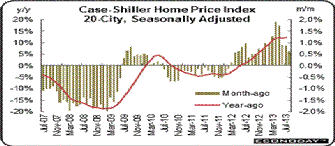The Mortgage Corner
Freddie Mac reported that the Single-Family serious delinquency rate declined in August to 2.64 percent from 2.70 percent in July. This has in large part to do with lower interest rates, which have declined again because the Fed decided not to begin to end its QE3 purchase program.
But it is also because housing prices are still rising strongly, with the Case-Shiller index up some 12.3 percent annually, and FHFA housing price index for conventional loans insured by Freddie Mac or Fannie Mae up 8.8 percent annually. This leaves about 5 million homes still with underwater mortgages, and so susceptible to serious delinquencies and outright foreclosure. But if economic activity continues to improve, then so will housing prices.
But rising housing prices are a two-edged sword, because though this helps existing home owners, it could become more difficult for homebuyers, since household incomes aren’t rising as well.
Freddie's serious delinquency rate is down from 3.36 percent in August 2012, and this is the lowest level since April 2009. Freddie's rate peaked in February 2010 at 4.20 percent. These are mortgage loans that are three monthly payments or more past due or in foreclosure, said Freddie Mac.
Mortgage rates for a 30-year fixed conforming mortgage have declined to approximately 4.125 percent for 0 origination points in some California areas, from as high as 5 percent 2 weeks ago. This still keeps the MBA Housing Affordability Index at its most recent low of 155 percent, which means households with a $62,868 annual median income can buy a home that is 155 percent higher than the national median price for existing-homes, or $331,700. The national median existing-home price has risen to $214,000, an increase of 25 percent from its 2012 low, which is why the Affordability Index isn’t rising.
Even if fewer prospective homebuyers are eligible to purchase, rental housing construction will benefit as rental vacancies are shrinking nationally and rents are rising. Reis, the commercial real estate research company, reported that the apartment vacancy rate declined in Q3 to 4.2 percent from 4.3 percent in Q2. While in Q3 2012 (a year ago) the vacancy rate was at 4.7 percent. The rate peaked at 8.0 percent at the end of 2009.
The question is now where will those forming new households live with rising rents and rising home prices? This will in large part be dependent on the employment picture, as household incomes can’t rise, unless households are more fully employed. And we won’t see much improvement in employment, as long as the Federal Reserve is the only government entity providing stimulus by keeping interest rates at historic lows.
Harlan Green © 2013
Follow Harlan Green on Twitter: www.twitter.com/HarlanGreen




No comments:
Post a Comment